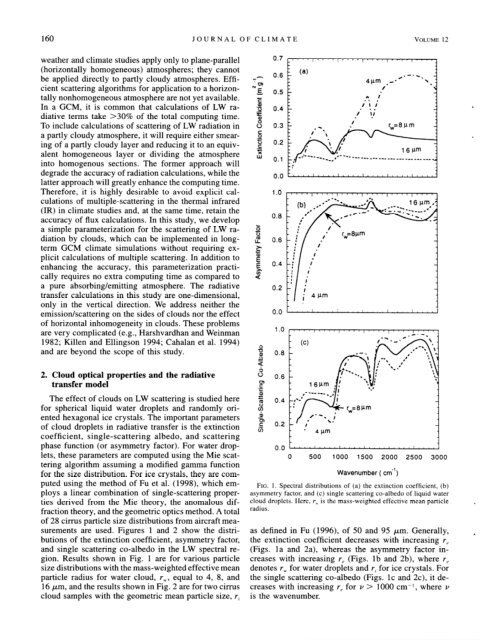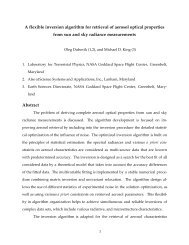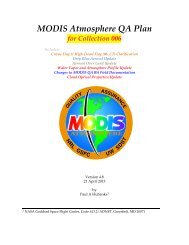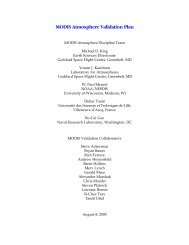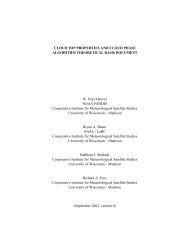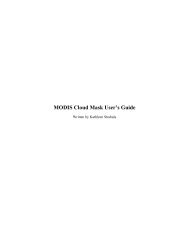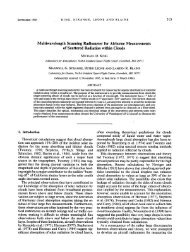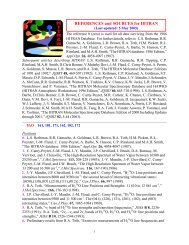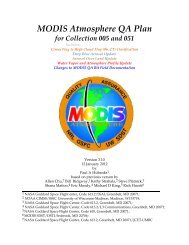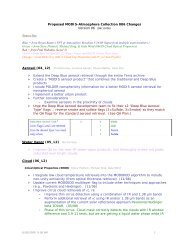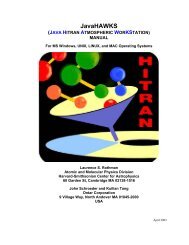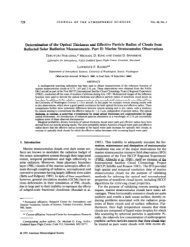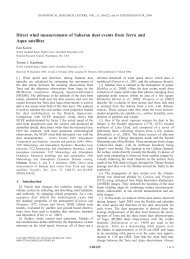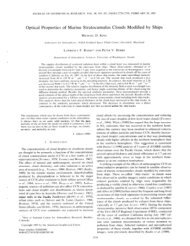Chou et al. (1999).pdf - MODIS Atmosphere - NASA
Chou et al. (1999).pdf - MODIS Atmosphere - NASA
Chou et al. (1999).pdf - MODIS Atmosphere - NASA
You also want an ePaper? Increase the reach of your titles
YUMPU automatically turns print PDFs into web optimized ePapers that Google loves.
weather and climate studies apply only to plane-par<strong>al</strong>lel<br />
(horizont<strong>al</strong>ly homogeneous) atmospheres; they cannot<br />
be applied directly to partly cloudy atmospheres. Effi-<br />
cient scattering <strong>al</strong>gorithms for application to a horizon-<br />
t<strong>al</strong>ly nonhomogeneous atmosphere are not y<strong>et</strong> available.<br />
In a GCM, it is common that c<strong>al</strong>culations of LW ra-<br />
diative terms take >30% of the tot<strong>al</strong> computing time.<br />
To include c<strong>al</strong>culations of scattering of LW radiation in<br />
a partly cloudy atmosphere, it will require either smear-<br />
ing of a partly cloudy layer and reducing it to an equiv-<br />
<strong>al</strong>ent homogeneous layer or dividing the atmosphere<br />
into homogenous sections. The former approach will<br />
degrade the accuracy of radiation c<strong>al</strong>culations, while the<br />
latter approach will greatly enhance the computing time.<br />
Therefore, it is highly desirable to avoid explicit c<strong>al</strong>-<br />
culations of multiple-scattering in the therm<strong>al</strong> infrared<br />
(IR) in climate studies and, at the same time, r<strong>et</strong>ain the<br />
accuracy of flux c<strong>al</strong>culations. In this study, we develop<br />
a simple param<strong>et</strong>erization for the scattering of LW ra-<br />
diation by clouds, which can be implemented in long-<br />
term GCM climate simulations without requiring ex-<br />
plicit c<strong>al</strong>culations of multiple scattering. In addition to<br />
enhancing the accuracy, this param<strong>et</strong>erization practi-<br />
c<strong>al</strong>ly requires no extra computing time as compared to<br />
a pure absorbing/emitting atmosphere. The radiative<br />
transfer c<strong>al</strong>culations in this study are one-dimension<strong>al</strong>,<br />
only in the vertic<strong>al</strong> direction. We address neither the<br />
emission/scattering on the sides of clouds nor the effect<br />
of horizont<strong>al</strong> inhomogeneity in clouds. These problems<br />
are very complicated (e.g., Harshvardhan and Weinman<br />
1982; Killen and Ellingson 1994; Cah<strong>al</strong>an <strong>et</strong> <strong>al</strong>. 1994)<br />
and are beyond the scope of this study.<br />
2. Cloud optic<strong>al</strong> properties and the radiative<br />
transfer model<br />
The effect of clouds on LW scattering is studied here<br />
for spheric<strong>al</strong> liquid water dropl<strong>et</strong>s and randomly ori-<br />
ented hexagon<strong>al</strong> ice cryst<strong>al</strong>s. The important param<strong>et</strong>ers<br />
of cloud dropl<strong>et</strong>s in radiative transfer is the extinction<br />
coefficient, single-scattering <strong>al</strong>bedo, and scattering<br />
phase function (or asymm<strong>et</strong>ry factor). For water drop-<br />
l<strong>et</strong>s, these param<strong>et</strong>ers are computed using the Mie scat-<br />
tering <strong>al</strong>gorithm assuming a modified gamma function<br />
for the size distribution. For ice cryst<strong>al</strong>s, they are com-<br />
puted using the m<strong>et</strong>hod of Fu <strong>et</strong> <strong>al</strong>. (1998), which em-<br />
ploys a linear combination of single-scattering proper-<br />
ties derived from the Mie theory, the anom<strong>al</strong>ous dif-<br />
fraction theory, and the geom<strong>et</strong>ric optics m<strong>et</strong>hod. A tot<strong>al</strong><br />
of 28 cirrus particle size distributions from aircraft mea-<br />
surements are used. Figures 1 and 2 show the distri-<br />
butions of the extinction coefficient, asymm<strong>et</strong>ry factor,<br />
and single scattering co-<strong>al</strong>bedo in the LW spectr<strong>al</strong> re-<br />
gion. Results shown in Fig. 1 are for various particle<br />
size distributions with the mass-weighted effective mean<br />
particle radius for water cloud, rw, equ<strong>al</strong> to 4, 8, and<br />
16 ,um, and the results shown in Fig. 2 are for two cirrus<br />
cloud samples with the geom<strong>et</strong>ric mean particle size, rr<br />
- 0.6<br />
7<br />
-: 0.5<br />
E<br />
.-<br />
g<br />
0.4<br />
$<br />
0 0.3<br />
%<br />
‘3<br />
is 0.2<br />
-t<br />
Ii 0.1<br />
0.8<br />
0.6<br />
1 .o<br />
0.8<br />
0.6<br />
0.4<br />
0.2<br />
0.0<br />
1 . w-n<br />
,,,,,,,,,,I,,,,,,,,,,,,,,!<br />
0 500 1000 1500 2000 2500 3000<br />
Wavenumber ( cm”)<br />
FIG. 1. Spectr<strong>al</strong> distributions of (a) the extinction coefficient, (b)<br />
asymm<strong>et</strong>ry factor, and (c) single scattering co-<strong>al</strong>bedo of liquid water<br />
cloud dropl<strong>et</strong>s. Here, T,+ is the mass-weighted effective mean particle<br />
radius.<br />
as defined in Fu (1996), of 50 and 95 pm. Gener<strong>al</strong>ly,<br />
the extinction coefficient decreases with increasing Y,<br />
(Figs. la and 2a), whereas the asymm<strong>et</strong>ry factor increases<br />
with increasing re (Figs. lb and 2b), where re<br />
denotes T%, for water dropl<strong>et</strong>s and T, for ice cryst<strong>al</strong>s. For<br />
the single scattering co-<strong>al</strong>bedo (Figs. lc and 2c), it decreases<br />
with increasing<br />
is the wavenumber.<br />
Y, for v > 1000 cm-‘, where v


